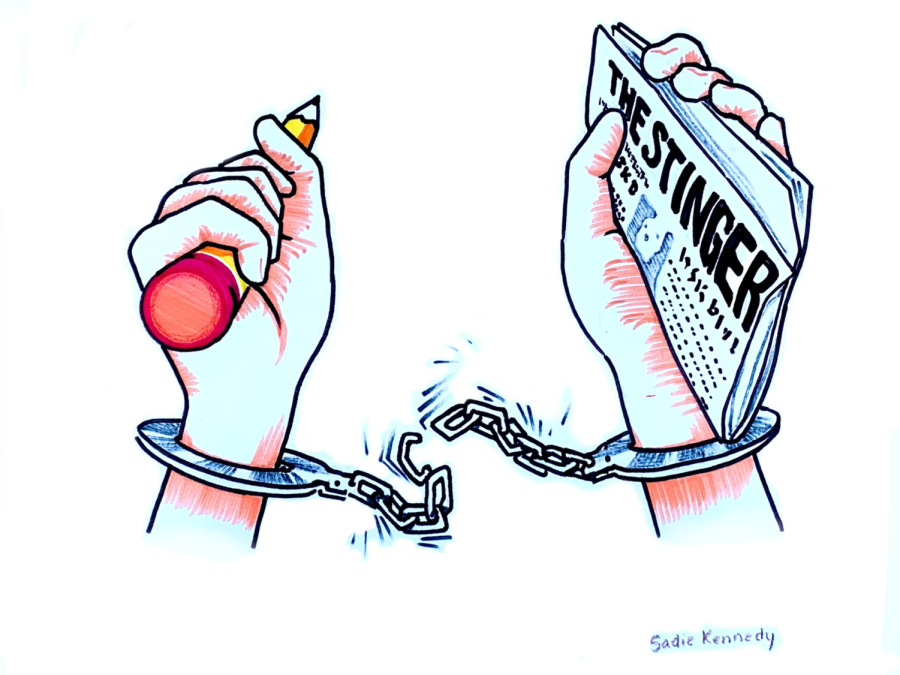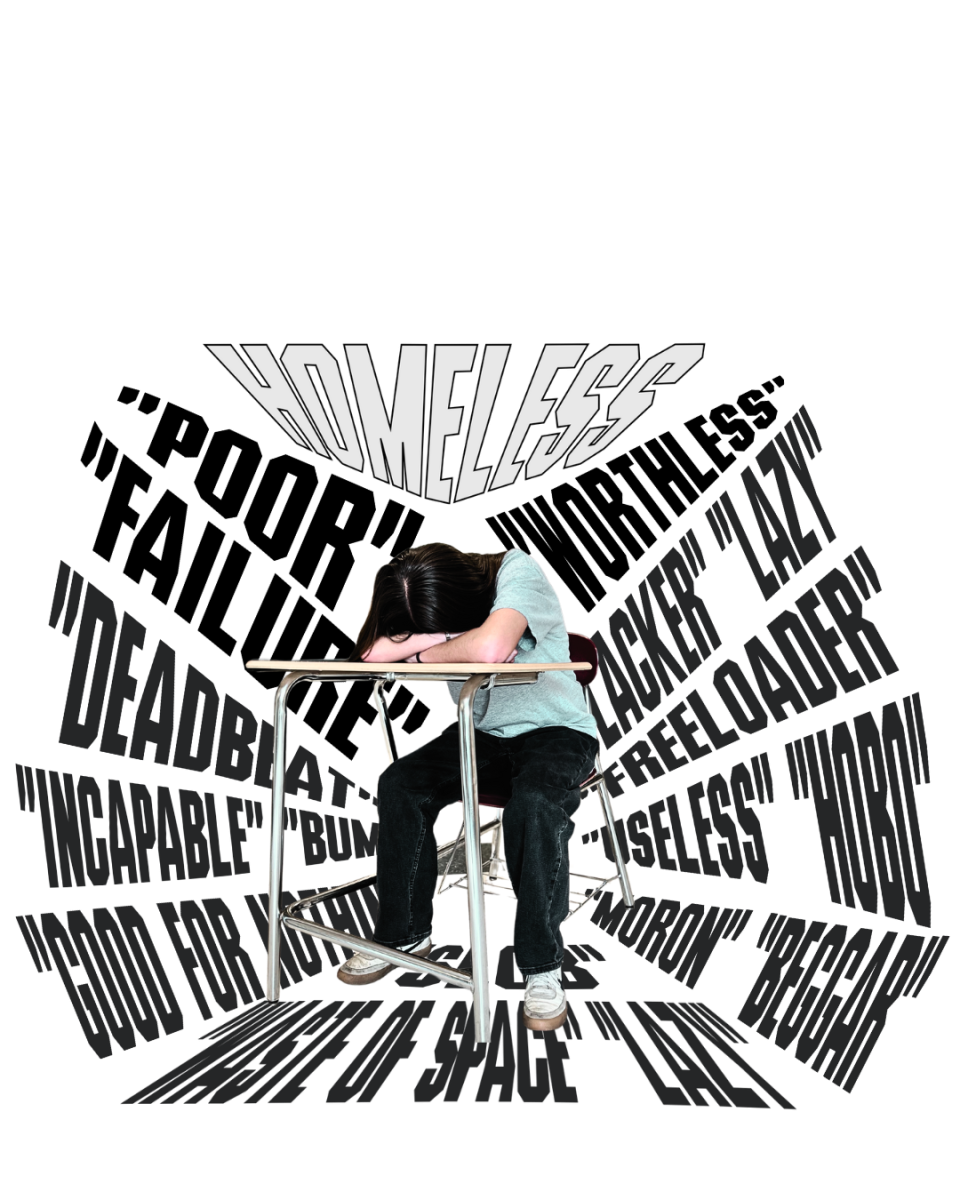The Stinger protects and supports student voices, right to free speech
February 24, 2022
This previously ran in our February 2022 print issue.
East Penn’s “Portrait of a Graduate” lists 10 traits the district wants to see in its graduating seniors. Among them: critical thinking, conscientious researching, collaborating, and calculated risk taking. Writing, reporting, and editing stories — authentic, uncensored stories — helps students possess all of these traits.
Critical thinking, specifically, is a skill that many across the political spectrum claim students must develop in order to make important decisions ranging from “What should I do with my life?” to “Should I wear a mask to the movie theater?” There’s little to no critical thinking involved in taking pre-approved administrative talking points and typing them onto a page for other people to read with a giant yawn. That’s not what we do at The Stinger, nor what journalists do in general. We question… everything. And that’s why, in celebration of Feb. 24, National Student Press Freedom Day, we’re taking a moment to remind our readers that reporting is, indeed, democracy in action.
Thankfully, the East Penn administration supports student press freedom. The main role of student journalism is to “highlight the importance of student voice and perspective,” Dr. Kristen Campbell, superintendent of schools, told The Stinger recently. Our principal concurs.
“Emmaus High School has a really strong, long tradition of supporting high quality student journalism,” Dr. Kate Kieres says.
Things could be different –– as they are at other public high schools across the nation.
Imagine if our school leaders only allowed The Stinger to write stories that painted administration in a positive light. Every cover, most likely, would feature Branch, and the inside pages would be filled with stories about awards and accolades, along with sugar-coated headlines like “EHS teachers say pandemic makes them stronger!” or “Super cool ways to decorate your locker.”
What an educated society needs is the facts — true stories that catalog pressing matters, not only in our high school, but within our district and community as a whole. Yes, sometimes those stories involve feel-good human interest pieces about students overcoming challenges and achieving accolades. Other times, however, stories explore uncomfortable topics like student homelessness, racial inequity, or food insecurity.
Student press freedom allows for students to talk about the decisions that impact them as well as the events in the world around them. For example, administration gave us no opportunity to give input on block scheduling before it suddenly appeared. With a free student press, however, we are able to voice our happiness (or our disdain) over such a decision. Student journalists have the power to bring about real change; it’s not just more prominent publications like The New York Times that uncover hard-hitting, important stories.
Student journalists can bring the heat, too.
Just look at the Hilltop Beacon, the newspaper for Roslyn High School in Long Island, NY. In 2004 they uncovered an ongoing fraud and embezzlement by administrators within their district. In 2017 a newly hired principal resigned at a Kansas high school after student journalists discovered that she falsely reported her professional credentials and work experience. Beyond the school walls, high school journalists in Louisville, Kentucky drew national attention in 2020 when they revealed that state police training materials used Adolf Hilter as the most-quoted person in their training materials that encouraged officers to be “ruthless killers.”
At Emmaus, The Stinger has continuously served its stakeholders for 100 years. This wouldn’t be possible without the support of administrators and board that currently allots our funding. Recently, when we wrote a story about EHS’s cockroach infestation, Kieres felt comfortable making herself available for an interview even though she was taking heat from parents, guardians, and students. We’re lucky, as Kieres says, to have a “board that… understands the role that you play and is open to being interviewed, or seeing an article be published.” She also remarks on the importance of this relationship.
“In order to have a successful program that’s true to its mission, you have to have building level leadership that supports you, you have to have district level leadership that supports you, you have to have a board that understands and supports what you’re trying to do,” Kieres said.
While everyone working together synchronously to support the paper would be ideal, as Kieres says, it does not always happen.
While many administrators and staff generally support the paper’s intent, they don’t necessarily make our job easy. Just this year, we struggled to obtain basic public information from some folks, such as the number of students enrolled in AP classes. This information is available to the public –– not just the press. But we were stonewalled. It shouldn’t be this way. Our intention is to serve the community. We shouldn’t have to compare trusted individuals inside our school with folks outside of our school who this year surreptitiously demanded the takedown of an award-winning article from our website. Why? Simply because they didn’t like the article and made threats to our web host, who erroneously caved and later apologized to us. While writing about topics such as teacher misconduct, racism within the district, school finances, and sexual misconduct is difficult and often unpleasant for some, we believe these stories must be told.
In short, everyone –– Stinger staff, teachers, administrators, other students, even the surrounding community — is better off with a free student press. When we write stories that generate discomfort — causing readers to question their own opinions and thoughts about a range of issues — we know we’ve succeeded in creating content worth reading. The freedom to report on and publish those stories is what allows us to find that delicate balance between gushing about Branch and making a larger impact on our community, inside and out.










